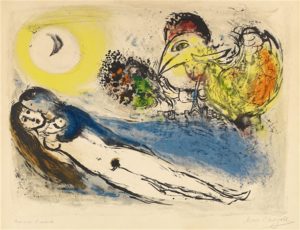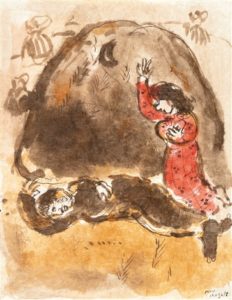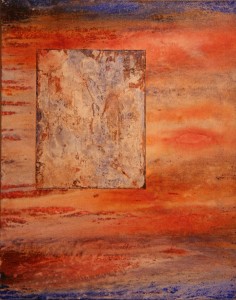Dear Artist,
Yesterday, Ann Price of Little Rock, Arkansas wrote, “You’ve written a lot about doing versus talking, and how speech inhibits creativity. I’ve been a talker since infancy. My parents swore I spoke sentences by six months. These days I’m repeatedly blocked creatively by my own verbal overload. Have you ever met someone who successfully made the switch from talker to doer?”

Repos sur coq et chevauchée au village rouge, ca. 1975–1978
gouache, tempera and ink on paper
65.3 x 50 cm
by Marc Chagall (1887–1985)
Thanks, Ann. Yes, I have, and I can tell by looking at your work that verbalization is something you’re fighting.
I’ve had to make the change myself. When I was a kid I learned that I could get out of scrapes by talking rather than fighting. I had to — I was a puny little guy. Later, after a few semesters at art school, the registrar called me in and told me, “You talk a good job and do a poor one.” This was when I realized I had to figure out how to be more quiet.
Short of stuffing a sock in the mouth, artists with this problem can beat it. They need to start with a courageous assessment of their own work. Look for literary and theoretical concepts that may be dominating creative elan and gestural confidence. Look for places in your art where you weren’t really looking. A good place to start is eyes. Eyes drawn or painted by a talker tend to have clear lids, white sclera and over-linear design. In other words they tend not to be three-dimensional sockets of light and shadow. The overly-talkative artist tends not to be looking at an eye, but rather drawing out the verbal elements that might describe an eye.
The overly-verbal artist is led by his understanding of things — rather than by direct observation of things as they are.
Something else worth watching for is overindulgence in symmetry. For some reason visual equality appeals to talkers — perhaps because of some atavistic need for balance. There’s nothing wrong with symmetry, but the valuable three-quarters views and unequal positioning of elements is more often the creative way. Not only that, it’s the more challenging way. Drawing and painting what you know can be fairly limiting. The idea is to become a visual blotter, soaking up with discriminating gusto what is truly seen. And if you feel the need to say something, with permission, kiss someone. Just puckering up can do the trick.
Best regards,
Robert
PS: “A kiss is a lovely trick designed by nature to stop speech when words are superfluous.” (Ingrid Bergman)
Esoterica: Whether we’re talkers or not, most of us have to unlearn habits and reboot our abilities. I’ve met many artists who improved their work by sheer willpower. And, as I’ve said somewhere before, the job requires character. Fact is, most people can draw and paint ideated images based on what they know, but it often takes a dedicated eye and an inactive tongue to overcome some pervasive shortcomings.
This letter was originally published as “Confessions of a puny little guy” on November 30, 2012.
The Letters: Vol. 1 and 2, narrated by Dave Genn, are available for download on Amazon, here. Proceeds of sales contribute to the production of The Painter’s Keys.
If I create from the heart, nearly everything works; if from the head, almost nothing. (Marc Chagall)
Featured Workshop
Join Julie Schumer and James Koskinas and take a leap into the unknown in this 2 1/2 day intensive acrylic workshop. Through a series of structured exercises designed to help you loosen up, we will explore various elements of a non-objective painting including color, composition, and eye flow, line, value and texture using acrylic paint and a variety of mark making tools.
Bring your artistic passion and the willingness to try something different and gain a new perspective. This workshop is available to all levels but is perfect for those new to abstract painting. Cost is $595.00. A materials list will be provided or materials can be provided for an additional $100.00
Featured Artist
Painting is my passion and joy. My process is intuitive, though informed by good composition and design principles. I paint what I remember, or think about, or feel, or just what comes off my hands to the brush to the canvas. Texture and color are of primary importance to me. I typically choose my support, texture it, select my palette, and go. There is nothing more satisfying to me than watching paint run and move. I love the surprises. I experiment and learn constantly. It is a remarkable journey. One I am pleased to share with you.








9 Comments
Bergman’s comment is witty, but, I think, wrong. A kiss is probably as close as we can get to eating love.
As adults, maybe so.
An infant feeding at its mother’s breast eats love too.
I was reading that the ability to paint was number three in importance to success. Number one was a good out going personality, number two was the ability to describe or tell a story about your work to involve the audience.
Getting around preconceived ideas is important in the ability to see, being able to talk is a blessing a lot of artists need.
Congrats – my first spit take today…I read something too.
“You want to paint? First of all you must cut off your tongue because your decision takes away from you the right to express yourself with anything but your brush.”
— Henri Matisse
Words can convey images in much the same way images can inspire words. Shouldn’t an artist be able to describe the thought behind the work? I just copied a call to entry which states ” The artist’s statement has a huge impact in selecting work.” All talk and no action is one thing….but the ability to articulate the visual during and after the process of creating it is also very important. I find the descriptive concept behind a visual work very interesting indeed.
Prsonally, I refer a piece of art that doesn’t ask me to read a thesis to enable me to get what it’s all about
Heather Lorenzon I agree completely. If I cannot enjoy the work without reading about it, it has nothing to say to me.
Work that needs a lot of explaining likely ain’t that great on its own. If your work speaks for itself, don’t interrupt.
“Soaking up with discriminating gusto what is truly seen” is a key idea Robert talks about in order to paint what is in existence and not what one might know as he gives in the example of the eye. An eye is really shapes, lines, light and shadow. I also agree with his discussion on symmetry. Oh how I would love to have known Robert and studied with him, a man of knowledge, wisdom and generosity with these wonderful God-given assets. And, personally, I don’t feel the need to explain or talk about my art unless someone asks for a discussion about some aspect of the piece. Thank you Sara for reposting this article.